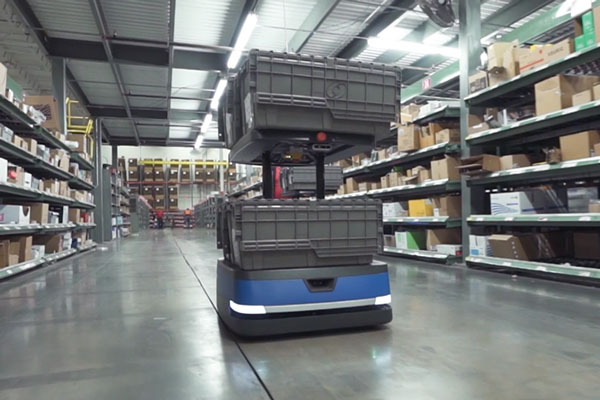How mobile robots empower the workforce
Office Depot’s deployment of collaborative mobile robots improves safety, energizes workforce.

Getting orders to customers quickly, accurately and at a competitive price attracts customers to omni-channel retailers like Office Depot. As one of the biggest providers of office supplies in the U.S. market, Office Depot ships about 600,000 packages each day to customers across the United States in what involves a mix of e-commerce, retail and business-to-business (B2B) orders.
Fulfilling orders on that scale, however, can be a labor intensive, physically demanding job without technology solutions to help lessen the amount of walking and other physical tasks. With demand shifting across e-commerce, B2B and retail, Office Depot is fulfilling more customer orders that contain fewer items per package.
This change in order profile unearthed challenges in the retailer’s manual, cart-powered fulfillment process. These issues include extensive time spent walking or “traveling” to pick locations, and the risk of injuries that can occur when pushing and handling carts.
The Office Depot team began to look into collaborative robots to address some of these challenges. Office Depot prioritized the following in its search for new warehouse automation:
- creating a flexible fulfillment process that adapts to changing customer needs,
- reducing ergonomic issues linked to maneuvering heavy manual carts,
- energizing warehouse associates with easy-to-use technology, and
- ramping fulfillment capacity to meet growing consumer demand.
Office Depot replaced its manual cart and pick-to-voice technology at a DC in Orlando, Fla., with a process that uses collaborative mobile robots (6 River Systems) to support efficient picking of e-commerce and store replenishment orders. The fleet of 18 autonomous mobile robots (AMRs) work in close collaboration with warehouse associates to get orders picked quickly and accurately with minimal walking for the workers.
The AMRs, or “Chucks” as the provider refers to the robots, use artificial intelligence (AI) to prioritize work and reduce walking. Associates stay in a relatively compact zone and pick to containers on the Chuck, which eliminates having to push a manual cart.
Associates use the Chucks to pick office supplies into discrete orders for shipping. The robots are termed collaborative because of the way they efficiently route warehouse associates through a set of picks in a relatively tight zone of the warehouse to minimize walking, while also guiding their work to confirm picks and presenting a visual indicator of which container to put items into.
The process involves three key steps. The first is a system-directed induct process in which an associate prepares a Chuck for its next set of work. This induct step triggers the system’s AI to allocate orders to the Chuck in a way that prioritizes work based on item location, shipping times and other configurable criteria. Associates working at induct load empty totes onto the robots and press confirm, at which point the Chucks travel on their own to a meeting point to connect with picking associates.
To start the next step, associates badge into Chucks at a meeting point and begin the picking process. Chucks lead workers from bin to bin within a zone for hands-free directed picking. When picking is complete, Chuck travels to another zone or to a take-off location and associates proceed to a nearby waiting Chuck and repeat the process.
Step three begins when all picks on a single Chuck are done. Chuck travels autonomously to take-off locations. The take-off process directs associates to remove each completed tote and prepare orders for shipment. Once done, the Chuck travels to induct to repeat the overall process. The provider supports two take-off locations at Office Depot, one where orders are taken off for dunnage to be applied and another where bag shipments are packed out.
As a result of the implementation, Office Depot improved warehouse safety, engaged and rallied its staff, reduced walking and sped up training. The warehouse was able to eliminate all injuries associated with their previous cart pick process, which required associates to manipulate heavy manual carts.
“In the past, we had ergonomic injuries related to back strain and shoulder strain and even wrist injuries,” said Michelle Williams, senior manager of process engineering. “All of those injuries have gone to zero since we’ve started using Chucks.”
Associates can be trained on Chuck and performing at target rates in a day. In addition, the team has eagerly adopted the technology. “As we embrace the technology of the 21st century, I believe this is a really good, positive step forward for Office Depot,” Williams said. “I’ve had people on the other side of the building asking, ‘when can I come and pick on Chuck?’”
Office Depot knows that the landscape of fulfillment is forever changing. Adopting technology like flexible robotic automation is key to helping the retail giant stay competitive.
“We’ve been in business for over 25 years and have experimented with a lot of different automation, from traditional conveyor to pick-to-voice to other robotic technologies,” says Bob Abbondanza, senior director of engineering and network design at Office Depot. “We chose Chuck because we are really focused on flexibility and safety within our operations.”

Article Topics
Latest in Logistics
LM Podcast Series: Assessing the freight transportation and logistics markets with Tom Nightingale, AFS Logistics Investor expectations continue to influence supply chain decision-making The Next Big Steps in Supply Chain Digitalization Under-21 driver pilot program a bust with fleets as FMCSA seeks changes Diesel back over $4 a gallon; Mideast tensions, other worries cited Four U.S. railroads file challenges against FRA’s two-person crew mandate, says report XPO opens up three new services acquired through auction of Yellow’s properties and assets More LogisticsAbout the Author
About the Author
Subscribe to Logistics Management Magazine

Find out what the world's most innovative companies are doing to improve productivity in their plants and distribution centers.
Start your FREE subscription today.
April 2023 Logistics Management

Latest Resources














